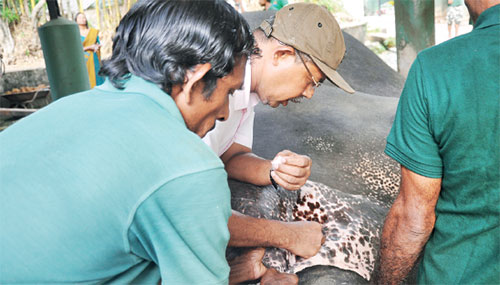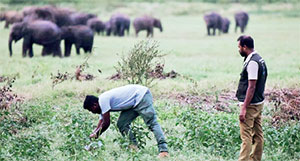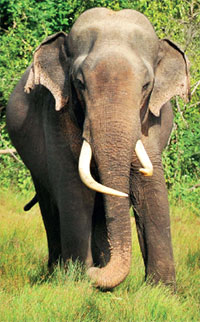News
Scientific team completes part of ongoing study on gene pool of 700 Lankan elephants

by Ifham Nizam
An eight-member scientific team has completed a comprehensive part of an ongoing study on the gene pool of 700 Sri Lankan elephants.
Department of Wildlife Conservation (DWC) and Agricultural Biotechnology Centre (AgBC) of the University of Peradeniya, are conducting a research on DNA analysis of wild elephants in Sri Lanka funded by the Ecosystem Conservation and Management Project (ESCAMP).
The scientific team comprises Ranjan Marasinghe, R. M. R. Nilanthi Rajapakse, H.A. Bhagya Hathurusinghe, Chandana Sooriyabandara, Dr. C. H. W. M. R. Bhagya Chandrasekara, Nuwan Jayawardana, M. Madawika Kodagoda, Dr. R. C. Rajapakse and Prof. Pradeepa. C. G. Bandaranayake.
 “The study will clearly indicate the differences of the Sri Lankan elephant as a sub species. Our molecular methodology is based on using elephant dung, and the test is similar to the Covid-19 PCR test”, Researcher R. M. R. Nilanthi Rajapakse told The Sunday Island.
“The study will clearly indicate the differences of the Sri Lankan elephant as a sub species. Our molecular methodology is based on using elephant dung, and the test is similar to the Covid-19 PCR test”, Researcher R. M. R. Nilanthi Rajapakse told The Sunday Island.
“We have already sequenced and assembled the genome of the Sri Lanka Wild Elephant (Elephas maximus maximus), the type subspecies of the Asian elephant. Comparative genomics work continues with available Asian and African elephant genomic data with the objective of identifying specific set of markers for the identification of Sri Lankan elephants”, the team said.
The first part of the research focused on 100 elephants, and it has now increased to 700 with continued focus on elephants in the forest patches etc., they remarked.
The project aims to examine the within-species genetic structure of the wild elephant across its range to better understand how genetically distinctive regional populations are and deviations of Sri Lankan elephants with those of other countries and how that might affect its conservation.
Conservation and management of elephants in Sri Lanka has become an important issue given the escalation of the Human-Elephant Conflict (HEC) and international trade of wild elephants.
The Asian elephant, Elephas maximus, is an umbrella species in tropical forests. Wild elephants play important roles in maintaining forest dynamics such as opening animal trails in the forests, creating open gaps that facilitate seed and acting as a seed disperser for large-seed fruit species. The conservation status of the Asian elephant has been recognized as an endangered species since 1986. Wild Asian elephants are currently distributed mainly in the South and Southeast Asia.
Habitat loss and fragmentation, anthropogenic disturbance, illegal poaching and HEC have been considered as significant threats to the Asian elephants, resulting in population decline and fragmentation. These threats resulted in skewed sex ratio and disruption of social organization.
 Acquiring information of wild populations is important for effective conservation and management of wild elephants.
Acquiring information of wild populations is important for effective conservation and management of wild elephants.
Wild elephants in Sri Lanka is estimated to be between 5,000 and 6,000, according to the last survey conducted by the DWC in 2011. This is a relative high number considering the small size of the country (65,610 sq. km) and the human population of over 21 million.
For management of elephants in the wild, monitoring the changes in the structure and composition of the populations would be far more useful than estimating elephant numbers.
Therefore, genetic methods will be useful for management and conservation plan such as individual and sex identification, population size estimation, population sex ratio, genetic diversity, relatedness among individuals in a population, gene flow among populations, detection of bottleneck event, phylogeography of particular species, detection of hybridization, providing evidence of illegal wildlife poaching, including being a tool for genetic management of a population and long-term monitoring of the managed population.
It provides genetic information of the populations that could not be obtained from field data collection alone. Genetic methods, on the other hand, provide reliable information on population structure and facilitate investigation of genetic effects on small and fragmented populations. Advance genetic methods also provide better estimations on population size with reasonable cost and time.
Further, tracking of ivory poaching would also be possible if a reference genetic database of the natural populations is available.
Molecular genetics studies on elephants’ date back to 1990s. Micro satellite markers have been the preferred choice and have played a major role in ecological, evolutionary and conservation research on elephants over the past 20 years.
However, technical constraints especially related to the specificity of traditionally developed micro satellite markers have brought to question their application, specifically when degraded samples are utilized for analysis. Therefore, the team analyzed the specificity of 24 sets of micro satellite markers frequently used for elephant molecular work.
“First, we optimized the DNA extraction protocol for elephant dung which can even be used for samples reach the lab within a week’s time because all previous studies depended on fresh dung samples collected less than 24 h time”, the team said.
“Comparative wet lab analysis was done with blood and dung DNA in parallel with in silico work. Our data suggest cross-amplification of unspecific products when field-collected dung samples are utilized in assays. The necessity of Asian elephant specific set of micro satellites and or better molecular techniques are highlighted”, the team pointed out.
The necessity of insilico analysis for testing specificity of SSRs is highlighted for other wild animals, for example, leopards. Nevertheless, the current study suggests that the analysis should extend beyond the human genome especially when dung DNA is used as starting materials. Therefore, the specificity of primers is a critical factor deciding the success of traditional SSR based methods adopted for such analysis.
Based on their study, no primer set out of 24 tested SSRs could be recommended for future work when the elephant dung is used as the starting material. If blood samples are drawn carefully with no human or other contamination, those with no multiple hits in the elephant genome, for example, EMU06 and EMU07 could still be used. As such, results of the previous studies done with elephant dung would be questionable with the evidence gathered from current findings.
“Nevertheless, no one could challenge the past since the revolutionary technologies pawed the path for the success of current studies. However, our results suggest the necessity of revisiting available methods. Alternatively, more specific,” the team stressed.
News
Maduru Oya helicopter crash: Army, Air Force launch probes

Bell 212 accident during passing out parade kills six military personnel, injures six others
A Bell 212 helicopter, belonging to the Sri Lanka Air Force (SLAF), crashed into the Maduru Oya reservoir yesterday morning, killing six forces personnel and injuring six others. The helicopter was on a routine mission in support of a Special Forces passing-out parade when it encountered technical difficulties and attempted an emergency landing.
The crash occurred at approximately 8:17 a.m., after the helicopter took off from the SLAF Base Hingurakgoda, at 6:47 a.m., and picked up Army personnel in Maduru Oya around 7:08 a.m. According to the SLAF, the aircraft was conducting a heli-rappelling drill as part of a military demonstration when it suffered a technical malfunction shortly after takeoff.
The aircraft was carrying 12 individuals—six from the Army and six from the Air Force, including two pilots. Initial rescue efforts led to all passengers being retrieved alive and transported to the Aralaganwila Regional Hospital, with eight later transferred to the Polonnaruwa General Hospital due to the severity of their injuries.
Despite emergency medical care, six of the personnel succumbed to their injuries—four Army Special Forces soldiers and two Air Force members. Among the deceased were helicopter gunmen and elite Special Forces troops.
In the wake of the tragedy, both the Army and Air Force have launched separate investigations to determine the cause of the crash. Air Force Commander Air Marshal Bandu Edirisinghe has appointed a nine-member inquiry committee, while Army Commander Lieutenant General Lasantha Rodrigo confirmed that expert teams have been dispatched to the crash site to gather evidence.
Air Force spokesperson Group Captain Eranda Geeganage said the crash occurred during a drill demonstration at the training school and that the exact cause of the accident remains unknown at this time.The remaining six injured personnel are still receiving treatment, with their conditions being closely monitored.
By Norman Palihawadane
News
Cardinal Prevost becomes Pope Leo XIV

Nearly half a century has passed since the Catholic Church last had an Italian Pope. In the hallowed corridors of the Vatican, as the Conclave began deliberations to elect a successor to Pope Francis, several Italian names were whispered with increasing frequency. Chief among them was Cardinal Pietro Parolin, the Vatican’s Secretary of State, a seasoned diplomat, and well-known among the electors. Others, like Cardinals Pierbattista Pizzaballa and Matteo Zuppi, also had their share of admirers.
Yet, when the white smoke rose above the Sistine Chapel, it was not an Italian who emerged. Instead, the Cardinals turned to an unheralded American – Robert Francis Prevost, a canon law professor and lifelong missionary – electing him as successor to St. Peter. He has taken the name Pope Leo XIV.
Though born in the United States, Pope Leo’s spiritual and pastoral heart lies in Peru, where he spent much of his life in missionary service. His elevation comes as a surprise to many as he had been made a Cardinal just two years earlier, appointed by Pope Francis himself. A relative newcomer in the College of Cardinals, he was seen by many as a wildcard – yet perhaps that’s exactly what the Church needed.
At 69, Pope Leo is poised for what could be a lengthy pontificate – time enough, perhaps, to carry forward the reforms initiated by his predecessor. It’s no secret that Pope Francis saw in him a leader fit for the challenges of global Catholicism. When Prevost returned from Peru to head the Augustinian Order – a role he held for 12 years – it was Francis who sent him back across continents, appointing him Bishop of Chiclayo and entrusting him with pastoral care once more in Peru.
Those close to the new Pontiff describe him as deeply spiritual, a steady hand, and a bridge-builder, qualities sorely needed in a Church increasingly split between traditionalists and reformists. He is expected to offer a more measured, balanced approach on key issues, fostering dialogue rather than division.
In many ways, this Conclave echoed the dramatic scenes of October 1978, when an unknown outsider from Poland – Karol Wojtyla – was chosen as Pope John Paul II. Like then, the Cardinals have once again looked beyond the obvious front-runners. But, unlike 1978, when it took eight ballots to break the deadlock and settle on a compromise, this time it took just four.
That speed speaks volumes. The Cardinals were not merely settling – they were convinced that here’s the man to take the Church forward. In Cardinal Prevost, they found a shepherd capable of steering the Church through a time of transition, someone who could temper Franciscan reform with pastoral wisdom and unite a divided flock under the banner of faith and humility.
By Rex Clementine
News
Appeals Court nullify appointment of RDA Director General

The Court of Appeal on Thursday issued a writ order nullifying the appointment of S.M.P. Suriyabandara as the Director General of the Road Development Authority (RDA), citing a breach of proper procedure. The Court found that the selection process was in violation of established appointment guidelines.
The Court directed the RDA and the Minister of Transport and Highways to appoint K.W. Kandambi to the post, with effect from 5th March 2024. Kandambi, a civil engineer with 23 years of service at the RDA, had outperformed Suriyabandara in the official interview process, scoring 61 marks compared to Suriyabandara’s lower score.
President’s Counsel Faizer Mustapha, representing Kandambi, argued that appointing a candidate with fewer marks was unlawful and requested the Court to invalidate the appointment.
Acting President of the Court of Appeal, Mohamed Lafar Tahir, ruled that the respondents had violated the law in their selection process, thus issuing the writ order to correct the appointment.
By A.J.A. Abeynayake
-

 Opinion6 days ago
Opinion6 days agoRemembering Dr. Samuel Mathew: A Heart that Healed Countless Lives
-

 Business4 days ago
Business4 days agoAitken Spence Travels continues its leadership as the only Travelife-Certified DMC in Sri Lanka
-

 Latest News3 days ago
Latest News3 days agoNPP win Maharagama Urban Council
-

 Business4 days ago
Business4 days agoLinearSix and InsureMO® expand partnership
-

 Business2 days ago
Business2 days agoJohn Keells Properties and MullenLowe unveil “Minutes Away”
-

 Features6 days ago
Features6 days agoTrump’s economic missiles are boomeranging
-

 Latest News6 days ago
Latest News6 days agoThe Heat index is likely to increase up to ‘Caution level’ at some places in Eastern, Northern, North-central and North-western provinces and in Monaragala and Hambantota districts.
-

 Business3 days ago
Business3 days agoNDB Bank partners with Bishop’s College to launch NDB Pixel awareness












